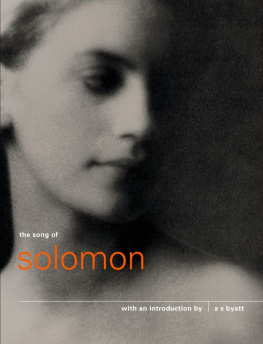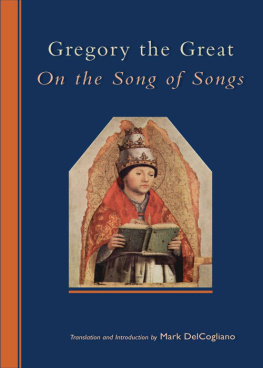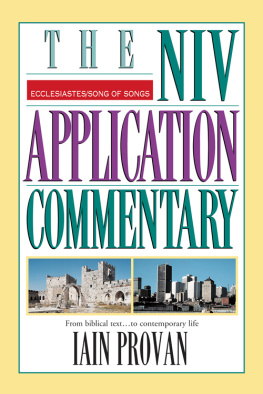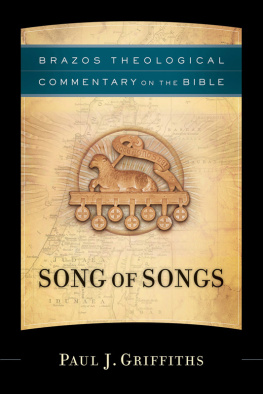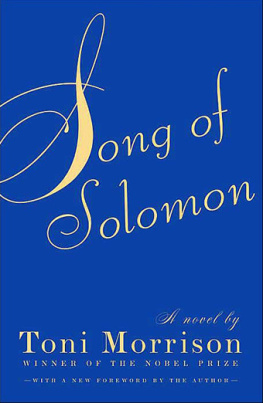Othmar Keel - The Song of Songs [Song of Solomon]
Here you can read online Othmar Keel - The Song of Songs [Song of Solomon] full text of the book (entire story) in english for free. Download pdf and epub, get meaning, cover and reviews about this ebook. year: 0, genre: Art. Description of the work, (preface) as well as reviews are available. Best literature library LitArk.com created for fans of good reading and offers a wide selection of genres:
Romance novel
Science fiction
Adventure
Detective
Science
History
Home and family
Prose
Art
Politics
Computer
Non-fiction
Religion
Business
Children
Humor
Choose a favorite category and find really read worthwhile books. Enjoy immersion in the world of imagination, feel the emotions of the characters or learn something new for yourself, make an fascinating discovery.
- Book:The Song of Songs [Song of Solomon]
- Author:
- Genre:
- Year:0
- Rating:5 / 5
- Favourites:Add to favourites
- Your mark:
- 100
- 1
- 2
- 3
- 4
- 5
The Song of Songs [Song of Solomon]: summary, description and annotation
We offer to read an annotation, description, summary or preface (depends on what the author of the book "The Song of Songs [Song of Solomon]" wrote himself). If you haven't found the necessary information about the book — write in the comments, we will try to find it.
The Song of Songs [Song of Solomon] — read online for free the complete book (whole text) full work
Below is the text of the book, divided by pages. System saving the place of the last page read, allows you to conveniently read the book "The Song of Songs [Song of Solomon]" online for free, without having to search again every time where you left off. Put a bookmark, and you can go to the page where you finished reading at any time.
Font size:
Interval:
Bookmark:


OF SONGS

Genesis 1-11
Claus Westermann
Genesis 12-36
Claus Westermann
Genesis 37-50
Claus Westermann
Psalms 1-59
Hans-Joachim Kraus
Psalms 60-150
Hans-Joachim Kraus
Isaiah 1-12
Hans Walter Wolff
Obadiah and Jonah
Hans Wolter Wolff
Haggai
Hans Walter Wolff
Micah
Hans Walter Wolff
Matthew 1-7
Ulrich Luz
Galatians
Dieter Luhrmann
Revelation
Jurgen Roloff
OTHMAR KEEL

OF SONGS

Translated by
Frederick J. Gaiser
[It is impossible for me] to despise that which is mistakenly called physical love; it is the substance of a sacrament, and I pay it the same respect I give to the unconsecrated bread, also the substance of a sacrament; the separation of love into so-called physical love and the other kind is open to criticism, perhaps inadmissible; no love is either purely physical or purely of the other kind; both always contain a portion of the other, even if only a tiny one. We are neither pure spirits nor pure bodies, and it may be that the angels envy us our ever-changing mixture of both.
Heinrich B611, Brief an einen jungen Katholiken
The Song of Songs has so much drama, so many experiences of longing and love, of good fortune and sorrow, that one can certainly enjoy the poems without lengthy commentary. They are effective in themselves, and long-winded explanations can only disturb the reader's personal appropriation of them. But one who comes to treasure these poems, and reads them again and again will eventually be directed by something in the text-perhaps a change in speaker or a particular simile or metaphor-to ask questions about what the songs really mean, about whether a particular interpretation is correct. These are, after all, poems from a distant and foreign world. So an expert who has studied that world and its languages will be summoned to begin an intellectual endeavor that will always be limited to particular issues. It can only provide interpretive helps and can never replace the poems themselves.
The present commentary has innumerable predecessors, and, even though the debate with them is limited, I did not want to omit it altogether. The interpreter stands in the midst of a serious conversation with other interpreters. Above all, I have engaged four recent major commentators: Rudolph, Gerleman, Pope, and Krinetzki (for the complete references, see the bibliography). These scholars represent four important streams of recent exegesis of the Song. Rudolph's commentary remains strongly in the tradition of Herder, Wetzstein (see note 24), and Budde, who used the analogy of modern recent Arab songs from Palestine and Syria to interpret the Song as a collection of folk songs, more or less directly connected with (peasant) wedding feasts. Gerleman understands the Song as literature, with a clear dependence on the love poetry of ancient Egypt. Pope seeks the roots of many of the Song's expressions and metaphors in Northwest Semitic philology and mythology (Ugarit) and in the sacred marriages of Sumer. Krinetzki strongly accents the form of the material and uses depth psychology to attempt to explain its motifs. Because my conversation with these authors is often lively, especially where disagreements are evident, I want to emphasize at the outset that the consensus is broader than the impression that may be given here.
I attempt to pay equal attention to the form and the content of the songs, with indirect reference to the Hebrew text. In order to shed light on the development and analysis of the various motifs I have sought to include both written and iconographic parallels; yet here too the format required that the results of many years of research be made as accessible as possible to the reader. Much of what is presented here is more fully developed in my preliminary study to this work: Deine Blicke sind Tauben. Zur Metaphorik des Hohen Liedes, SBS 114/115 (Stuttgart: Katholisches Bibelwerk 1984). But some things are not treated there and are new here-for example, all the observations about the delineation and structure of the individual poems and also much of the material about the background of the motifs. Only 50 of the present 158 illustrations are found in the preliminary study.
In this commentary I cite Hebrew or other foreign languages only when necessary. The traditional terms "perfect" and "imperfect" are used for the two most important forms of the Hebrew verb. In narrative texts, the Hebrew perfect can be rendered with the English imperfect, perfect, or past perfect; in the case of verbs signifying the mental or physical state of the subject (verbal adjectives) and verbs of perception, it often has a present sense. Finally, the perfect can also vividly portray future events as though in the present. The Hebrew imperfect is employed chiefly for repeated and continuous actions in the past and present, for future transactions and events, and to give modal meanings (should, may, can, etc.).
I am grateful to my friend and colleague, Dominique Barthelemy; conversations with him about introductory questions, especially regarding the process of canonization, were invariably profitable. As always, and with more love than ever, my wife contributed a large number of the drawings. The book is dedicated to our sister-in-law, Esther Leu, and our friend, Hans Heinrich Schmid.
Othmar Keel
Whereas Professor Keel provides his own German translation of the Hebrew text of the Song, this English version makes use of the NRSV as the standard translation. Where Keel's translation differs markedly from the NRSV, the latter is replaced with an English rendering of the former. Such material is enclosed in brackets. Words in parentheses are additions to the Hebrew text made by Keel in his German translation. Angle brackets signal material that Keel deems to be a gloss.
Professor Keel provided his own translation of the Egyptian texts cited. Here standard English translations have been used whenever possible, seeking the version that best renders Keel's meaning. Where no English version was adequate, Keel's German has been translated into English. This material is enclosed in brackets. Other parentheses and brackets in nonbiblical texts are those of the several translations cited and do not, therefore, have uniform meaning in the present commentary.
Standard English translations of the Egyptian love songs do not use completely uniform reference systems. For consistency, the system employed throughout this book is that of M. V. Fox (The Song ofSongs and the Ancient Egyptian Love Songs [Madison: University of Wisconsin Press, 1985]), even when the translation itself comes from another source.
Font size:
Interval:
Bookmark:
Similar books «The Song of Songs [Song of Solomon]»
Look at similar books to The Song of Songs [Song of Solomon]. We have selected literature similar in name and meaning in the hope of providing readers with more options to find new, interesting, not yet read works.
Discussion, reviews of the book The Song of Songs [Song of Solomon] and just readers' own opinions. Leave your comments, write what you think about the work, its meaning or the main characters. Specify what exactly you liked and what you didn't like, and why you think so.

![Othmar Keel The Song of Songs [Song of Solomon]](/uploads/posts/book/82605/thumbs/othmar-keel-the-song-of-songs-song-of-solomon.jpg)



